51 Tips Ahli tentang Metode Kontrol Inventaris:Memilih Metode Kontrol Inventaris, Tips Pengumpulan dan Analisis Data, dan Menerapkan Kebijakan Kontrol Inventaris yang Baik
Kontrol inventaris adalah fungsi penting untuk bisnis yang mencakup setiap industri. Tanpa metode pengendalian persediaan yang efektif, rantai pasokan menderita, Anda tidak dapat memenuhi kebutuhan pelanggan secara memadai, dan pada akhirnya, laba perusahaan Anda akan mencerminkan kekurangan ini.
Tetapi memilih metode yang tepat untuk pengendalian persediaan dan mengembangkan kebijakan yang efektif untuk memastikan bahwa proses diikuti, meningkatkan keakuratan metode kontrol inventaris Anda, dan mengumpulkan data yang akurat untuk memahami cara menggunakan data tersebut untuk menginformasikan area bisnis lainnya adalah masalah tanpa solusi menyeluruh yang sederhana.
Itulah sebabnya mengevaluasi skenario bisnis perusahaan Anda saat ini untuk mengidentifikasi kebutuhan utama dan memilih sistem serta mengembangkan proses yang paling sesuai dengan kebutuhan unik ini sering kali merupakan langkah pertama yang diperlukan bagi perusahaan yang memilih sistem kontrol inventaris untuk pertama kalinya. Ada baiknya juga bagi perusahaan untuk melakukan audit ini secara berkala untuk memastikan bahwa sistem dan proses saat ini memadai dengan mempertimbangkan pertumbuhan atau perubahan yang terjadi dalam organisasi.
Untuk membantu perusahaan memilih atau mengembangkan metodologi yang sesuai dengan bisnis persyaratan, kami telah menyusun daftar 51 kiat ahli tentang metode pengendalian inventaris, mulai dari informasi untuk membantu Anda memilih kerangka kerja atau metodologi pengendalian inventaris yang tepat hingga memahami kebutuhan bisnis unik perusahaan Anda dan membuat serta menerapkan kebijakan pengendalian inventaris yang efektif. Untuk menjelajahi kiat di bagian tertentu, gunakan tautan di bawah untuk menavigasi ke setiap kategori.
Langsung ke:
- Memilih Metode Kontrol Inventaris yang Tepat
- Dasar-dasar Kontrol Inventaris
- Tips Pengumpulan dan Analisis Data untuk Kontrol Inventaris yang Efektif
- Mengetahui Inventaris Anda dan Kebutuhan Perusahaan Anda
- Membuat Kebijakan Kontrol Inventaris yang Efektif
Memilih Metode Kontrol Inventaris yang Tepat
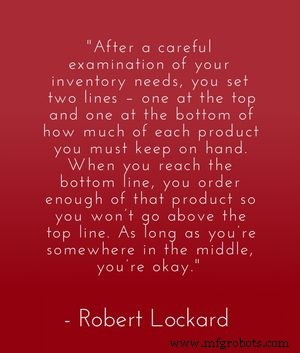
1. Metode kontrol inventaris Min-Max membantu Anda menentukan berapa banyak inventaris yang harus Anda pertahankan untuk item tertentu. “Setelah pemeriksaan yang cermat terhadap kebutuhan inventaris Anda, Anda menetapkan dua baris – satu di bagian atas dan satu di bagian bawah berapa banyak setiap produk yang harus Anda simpan. Ketika Anda mencapai garis bawah, Anda memesan cukup banyak produk itu sehingga Anda tidak akan melampaui garis atas. Selama Anda berada di tengah-tengah, Anda baik-baik saja.
“Kelebihan:Metode ini sederhana dan membuat tugas menyeimbangkan inventaris cukup mudah.
“Kekurangan:Kesederhanaannya dapat menyebabkan masalah karena Anda mungkin memesan terlalu banyak produk atau kehabisan sebelum tiba.” – Robert Lockard, 4 Metode Kontrol Inventaris yang Perlu Anda Ketahui , Perangkat Lunak Sistem Inventaris; Twitter:@Fishbowl
2. Metode ABC adalah salah satu metode kontrol inventaris yang paling umum digunakan di beberapa industri. “Ini adalah salah satu metode umum yang digunakan di seluruh industri ritel dan terkadang digabungkan dengan metode lain untuk kontrol inventaris yang lebih baik. Ini lebih merupakan teknik klasifikasi inventaris di mana produk diklasifikasikan berdasarkan kontribusi penjualan dan pentingnya hal yang sama dalam rencana pemilihannya.
“Produk kategori A akan menjadi penjual maksimum dalam penjualan dan produk unggulan dengan margin lebih tinggi . Biasanya 20% teratas dari produk dalam bermacam-macam yang berkontribusi terhadap 80% dari total penjualan diklasifikasikan dalam kategori A di mana kontrol ketat pada inventaris diperlukan untuk memastikan tidak ada kerugian dalam penjualan. 20% produk yang berkontribusi terhadap 80% penjualan dikenal sebagai Aturan 80-20 atau prinsip Pareto
“Produk C-Category berada di urutan terbawah yang berkontribusi lebih sedikit terhadap penjualan. Barang-barang ini sedikit penting untuk bisnis dan disimpan hanya untuk satu-satunya tujuan kebutuhan pelanggan.
“Produk Kategori B penting bagi pengecer tetapi kurang penting dibandingkan dengan produk Kategori A.” – Suresh Ram, Jenis Sistem Kontrol Inventaris , Diskusikan Ritel Secara Detail
3. Inventaris yang Dikelola Vendor adalah opsi untuk beberapa industri. “Sesuai namanya, vendor-managed inventory (VMI) adalah inventaris yang dikelola oleh vendor (pemasok). Dan meskipun ada lebih dari itu, setidaknya ini berarti vendor menentukan kapan harus mengisi kembali dan berapa banyak yang harus diisi kembali.
“Inventaris yang dikelola vendor bukanlah hal baru; sebenarnya sudah ada sejak lama dan jauh lebih umum daripada yang mungkin Anda pikirkan. Jika Anda pernah bekerja di sebuah restoran, Anda akan melihat "pemilik roti" muncul setiap hari atau lebih, periksa inventaris Anda (lihat secara fisik roti, roti, dll.), lalu pergi ke truknya dan siapkan persediaan untuk Anda. . Di tempat pangkas rambut, banyak produk rambut yang dijual atau digunakan oleh tukang cukur Anda (ya saya jadul, saya pergi ke tukang cukur) juga dikelola oleh pemasok. Dalam hal ini, mungkin perwakilan penjualan untuk produk itu yang benar-benar "mengelola" inventaris, dan dia dapat mengisi kembali barbershop dari bagasi mobilnya. Di toko perangkat keras independen lama, barang-barang seperti mur, baut, ring, o-ring, dll. sering dikelola oleh vendor. Dalam bisnis yang lebih besar, Anda mungkin memiliki karton pengiriman, perlengkapan kantor, atau perlengkapan kebersihan/pemeliharaan yang dikelola oleh vendor.” – Dave Piasecki, Vendor-Managed Inventory (VMI):Apa itu dan Kapan Penggunaannya Masuk Akal , InventoryOps.com
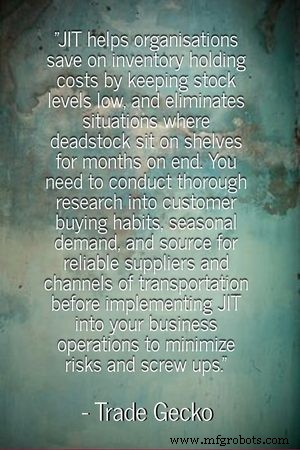
4. Metode pengendalian inventaris Just In Time dianggap sebagai praktik yang berisiko, tetapi metode ini mengurangi volume inventaris yang disimpan oleh bisnis, yang dapat mengurangi biaya overhead. “Metode Just In Time (JIT) berfungsi untuk mengurangi volume inventaris yang dimiliki bisnis. Ini dianggap sebagai teknik yang berisiko karena Anda hanya membeli persediaan beberapa hari sebelum diperlukan untuk distribusi atau penjualan sehingga barang tiba tepat pada waktunya untuk digunakan.
“JIT membantu organisasi menghemat biaya penyimpanan persediaan dengan menjaga tingkat persediaan rendah, dan menghilangkan situasi di mana deadstock duduk di rak selama berbulan-bulan. Anda perlu melakukan penelitian menyeluruh tentang kebiasaan membeli pelanggan, permintaan musiman, dan sumber pemasok dan saluran transportasi yang andal sebelum menerapkan JIT ke dalam operasi bisnis Anda untuk meminimalkan risiko dan kesalahan.” – Teknik Manajemen Inventaris , Dagang Tokek; Twitter:@tradegecko
5. Metode persediaan multi-periode memiliki dua variasi utama:kuantitas pesanan tetap dan pemesanan periode waktu tetap. “Model persediaan multi periode dapat memiliki dua variasi. Sistem kuantitas pesanan tetap adalah di mana pesanan ditempatkan untuk jumlah yang tetap setiap kali mereka ditempatkan. Penempatan pesanan dilakukan ketika suatu peristiwa terjadi – seperti mencapai tingkat stok minimum. Variasi kedua adalah model periode waktu tetap di mana pesanan ditempatkan pada waktu tertentu, misalnya ketika ada tinjauan bulanan tingkat stok. Jumlah pesanan akan tergantung pada jumlah persediaan yang dibutuhkan.
“Perbedaan utama antara model ini adalah bahwa dalam model kuantitas pesanan tetap harus ada pemantauan terus-menerus untuk memastikan bahwa pesanan ditempatkan ketika tingkat persediaan berada. dikurangi ke tingkat yang sesuai. Tingkat persediaan dalam model periode waktu tetap hanya diperiksa pada saat pesanan akan dilakukan. Dalam model kuantitas pesanan tetap, tingkat persediaan biasanya lebih tinggi dan sistem ini cenderung digunakan untuk barang-barang penting yang lebih mahal. Ini juga membutuhkan lebih banyak waktu untuk pemeliharaan karena model persediaan perlu diukur secara konstan.
“Model kuantitas pesanan tetap digunakan dalam situasi yang sangat stabil di mana permintaan produk konstan, waktu tunggu produk diketahui dan dapat diandalkan, harga tidak bervariasi, biaya pemesanan konstan dan semua pesanan untuk produk akan dipenuhi.” – Peter Carr, Minggu 7:Pengelolaan Inventaris , BE 603 Operasi dan Manajemen Rantai Pasokan (ditawarkan oleh Conrad Center for Business Entrepreneurship and Technology di University of Waterloo); Twitter:@UWaterloo
6. Metode kontrol inventaris yang paling efektif dapat bervariasi dari satu perusahaan ke perusahaan lain, dan bahkan untuk kategori item individual. “Metode pengendalian persediaan bervariasi dari perusahaan ke perusahaan, komoditas ke komoditas dan SKU ke SKU. Metode pengendalian persediaan yang paling cocok untuk barang yang bergerak lambat mungkin tidak berfungsi dengan baik untuk barang yang bergerak cepat. Sebuah perusahaan mungkin memiliki 1 juta SKU yang berbeda dan hanya menggunakan lima metode pengendalian persediaan yang berbeda. Satu hal yang perlu diingat — tidak ada metode yang sempurna untuk mengelola inventaris. Cawan suci atau formula ajaib yang menghasilkan tingkat inventaris yang sempurna tidak ada. Perusahaan hanya dapat mencari metode terbaik yang menghasilkan pengurangan biaya dan peningkatan tingkat layanan.” – Kenneth Hamlett, Metode untuk Kontrol Inventaris , kron.com; Twitter:@HoustonChron
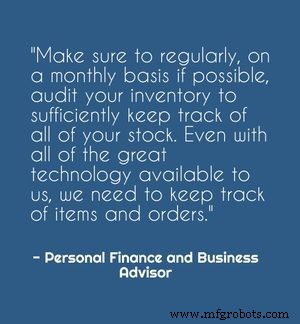
7. Meskipun tidak selalu ada metodologi pengendalian inventaris satu ukuran untuk semua, mengembangkan sistem kontrol inventaris yang jelas dan kebijakan terkait sangat penting untuk keberhasilan perusahaan mana pun. “Untuk memahami berbagai teknik manajemen inventaris, penting untuk mengetahui mengapa itu penting.
- Pertama, inventaris yang salah urus dapat menyebabkan peningkatan modal kerja yang tidak perlu. Kelebihan dana dapat diarahkan dengan bermanfaat untuk mendorong inisiatif pertumbuhan atau upaya penelitian dan pengembangan perusahaan.
- Kedua, manajemen persediaan yang efektif akan menghasilkan biaya penyimpanan yang rendah, yang pada gilirannya akan meningkatkan keuntungan perusahaan. Ruang penyimpanan mahal; jika Anda dapat mengelola inventaris dengan baik dan dapat mengurangi jumlah barang yang perlu disimpan, maka Anda akan membutuhkan lebih sedikit ruang, yang pada gilirannya akan menyebabkan biaya sewa gudang yang rendah.
- Ketiga, ini dapat membantu Anda memuaskan pelanggan dengan menyediakan produk yang mereka butuhkan secepat mungkin. Manajemen persediaan yang buruk menyebabkan ketersediaan barang yang lebih rendah dan waktu pengiriman yang lebih tinggi. Oleh karena itu, jika Anda ingin mendapatkan bintang kepuasan layanan tersebut, Anda perlu mengelola inventaris Anda dengan baik.
- Keempat, barang yang disimpan dalam persediaan dalam waktu lama dapat rusak. Hal ini menyebabkan overhead yang tidak perlu dalam menjalankan bisnis. Oleh karena itu, manajemen inventaris yang tepat dapat sangat membantu Anda mengurangi biaya tersebut.
- Kelima, jika Anda memiliki persediaan yang tersebar di berbagai lokasi, Anda memerlukan sistem yang tepat untuk mengelola persediaan tersebut berdasarkan permintaan dan penawaran. Teknik manajemen inventaris dapat membantu Anda mengelola banyak inventaris.” – Laran Joseph, Teknik Manajemen Inventaris dan Kepentingannya , Blog Udemy; Twitter:@Udemy_Blog
8. Cari fitur utama untuk mengevaluasi sistem yang memungkinkan Anda mengelola inventaris perusahaan Anda secara digital. “Tidak, kami tidak bermaksud menggunakan Excel untuk melacak inventaris Anda. Kami mengacu pada solusi Manajemen Inventaris yang sesuai untuk bisnis Anda. Tidak semua program di luar sana akan bekerja untuk semua orang, jadi luangkan waktu untuk mengevaluasi fitur dan fungsi untuk memastikannya memenuhi kebutuhan Anda serta kebutuhan bisnis Anda. Berikut adalah beberapa kiat hebat dalam mengevaluasi sistem manajemen inventaris.
- Berbasis web: Memiliki solusi berbasis web akan terbukti sangat berharga. Jenis Sistem Kontrol Inventaris ini sering kali lebih ramah anggaran, menawarkan lebih banyak fitur, dan biasanya lebih mudah diterapkan.
- Inventaris Seluler: Dapatkah Anda membawa sistem Manajemen Inventaris saat bepergian? Berbasis web saja tidak cukup, jadi pastikan sistem Anda menawarkan iPad, iPhone, Android, atau Windows Mobile yang kompatibel.
- Integrasi kode batang: Barcoding memungkinkan Anda mengurangi kesalahan entri data, mempercepat proses kontrol inventaris sekaligus membuat operasi sehari-hari Anda lebih mudah.
- Konversi Satuan Pengukuran: Menggunakan sistem yang memahami unit pengukuran pembelian Anda seringkali berbeda dari unit pengukuran inventaris Anda sangat penting. Anda dapat membeli "widget" Anda dengan "kotak" dari Acme Supply, tetapi Anda dapat mengeluarkan "widget" yang sama kepada staf Anda dengan unit pengukuran "setiap". Sering kali Anda mungkin melihat skenario di mana mungkin ada 50 "masing-masing" dalam satu "kasus" yang dipesan. Sangat penting bagi sistem pengelolaan inventaris Anda untuk mengetahui dan memahami proses ini.
- Impor Data: Mengimpor data Anda pada awalnya akan menghemat berjam-jam, jika tidak berhari-hari mengetik tangan di semua persediaan Anda. Pastikan untuk memeriksa fungsi ini.
- Proses Batch: Tidak ada yang suka harus melakukan tugas yang sama berulang-ulang; pastikan sistem yang Anda pilih menawarkan Transaksi Massal atau Proses Massal untuk mengubah pekerjaan besar menjadi tugas yang mudah dilakukan.
- Jumlah Siklus / Fisik: Akhirnya jumlah persediaan di rak Anda tidak akan sama dengan jumlah barang tersebut di Perangkat Lunak Manajemen Inventaris Anda, jadi Penghitungan Siklus atau Penghitungan Fisik persediaan Anda harus cepat dan mudah. Pastikan sistem yang Anda pilih menawarkan cara cepat dan mudah untuk menjalankan fungsi ini.
- Peringatan dan Pemberitahuan: Tetap terinformasi dengan Low Par Alerts dan berbagai notifikasi sistem lainnya secara otomatis. Tidak ada yang menyukai kejutan dan dengan lansiran otomatis Anda tidak akan terkejut lagi.” – 5 Praktik Terbaik Sederhana untuk Pengelolaan Inventaris yang Hebat , Grup Perangkat; Twitter:@TheToolkitGroup
Dasar-dasar Kontrol Inventaris
9. Sistem kontrol inventaris Anda harus berisi beberapa elemen kunci. “Setiap operasi suku cadang memerlukan semacam sistem kontrol inventaris, yang harus menggabungkan elemen-elemen kunci berikut:
- Ini harus memperingatkan personel suku cadang jauh sebelumnya bahwa ada suku cadang yang kehabisan stok.
- Ini harus mencantumkan harga pembelian historis suku cadang sehingga jika harga berubah, manajer akan dapat memeriksa masalahnya dan memastikan apakah perubahan ini merupakan kenaikan harga atau karena penagihan yang salah.
- Ini harus mencantumkan vendor yang menawarkan harga terbaik.
- Ini harus memberikan tingkat penggunaan sebelumnya sehingga pengelola dapat menentukan tingkat inventaris yang tepat.
- Ini harus membutuhkan penulisan sesedikit mungkin, terutama oleh mekanik.” – John Dolce, 15 Tips untuk Meningkatkan Kontrol Inventaris Anda , Utilitas Armada Profesional; Twitter:@UtilityFleetPro
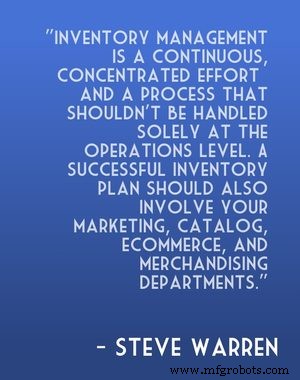
10. Buat rencana terlebih dahulu, lalu jalankan. “Manajemen inventaris adalah upaya yang berkelanjutan dan terkonsentrasi – dan proses yang tidak boleh ditangani hanya pada tingkat operasi. Rencana inventaris yang sukses juga harus melibatkan departemen pemasaran, katalog, e-niaga, dan merchandising Anda.
“Dengan mengelola inventaris Anda berdasarkan kalender promosi utama, semua orang menang:tim pembelian Anda memahami kapan dan berapa banyak produk yang harus dibeli, pemenuhan Anda penyedia tahu kapan harus menyiapkan ruang gudang tambahan, dan staf pusat kontak Anda dapat mengantisipasi peningkatan volume panggilan.
“Tambahkan perkiraan penjualan tahun-tahun sebelumnya ke kalender inventaris Anda agar lebih siap menghadapi lonjakan permintaan musiman.” – Steve Warren, 4 Tips untuk Pengelolaan Inventaris yang Efektif , Pedagang Multisaluran; Twitter:@mcmerchant
11. Identifikasi suku cadang penting untuk inventaris pemeliharaan dan pastikan tersedia setiap saat. “Sudahkah Anda mengidentifikasi suku cadang penting Anda? Suku cadang kritis =Lead time yang lama (4-6 minggu) X Penting untuk Peralatan Produksi X Biaya Suku Cadang Tinggi. Bagian-bagian ini seperti asuransi jiwa. Anda berharap Anda tidak pernah membutuhkannya, tetapi lebih baik ada di rak jika Anda membutuhkannya.” – Meningkatkan Kontrol Inventaris Pemeliharaan , Institut Marshall; Twitter:@Marshall_Inst
12. Pengiriman harus ditinjau dengan cermat, karena menerima inventaris adalah titik kunci kehilangan. “Poin kunci kerugian adalah pada saat menerima inventaris. Meninjau dengan cermat slip pengepakan ke pengiriman katalog diperlukan untuk manajemen inventaris. Anda juga ingin memeriksa barang dengan cermat sebelum perusahaan pengiriman pergi jika Anda perlu mengajukan klaim kerusakan. Setiap pengiriman harus diperiksa dengan cermat, dan ini harus mencakup penghitungan produk dan membandingkannya dengan slip pengepakan. Perbedaan perlu diperhatikan, dan jika perlu, klaim harus diajukan ke vendor yang bertanggung jawab atas pengiriman.” – Kelola Inventaris Anda , kubis; Twitter:@KabbageInc
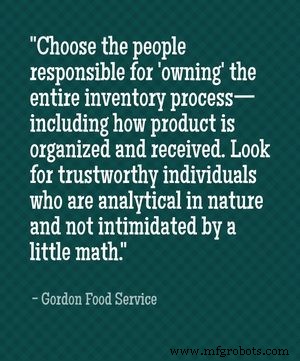
13. Tetapkan tim manajemen inventaris yang tepat dengan tugas untuk memiliki proses kontrol inventaris organisasi Anda. “Pilih orang yang bertanggung jawab untuk 'memiliki' seluruh proses inventaris—termasuk bagaimana produk diatur dan diterima. Carilah individu yang dapat dipercaya yang bersifat analitis dan tidak terintimidasi oleh sedikit matematika.” – 7 Tips untuk Meningkatkan Inventaris Operasi Anda dan Mengurangi Limbah Makanan , Layanan Makanan Gordon; Twitter:@GFSDelivers
14. Seperti inventaris harus memiliki satu lokasi penyimpanan, dengan pengecualian lokasi kelebihan stok jika perlu. “Bawa inventaris seperti itu ke dalam satu lokasi penyimpanan. Bagian yang sama tidak boleh berada di beberapa area penyimpanan kecuali ukuran fisik menentukan batasan. Dalam hal ini, pertahankan jumlah yang tersedia seminimal mungkin dan pindahkan sisanya ke lokasi yang bukan merupakan bagian dari penyimpanan yang mudah diakses (lokasi kelebihan stok).” – Tips Manajemen Gudang untuk Inventaris Hitung Fisik , riteSoft
15. Kontrol inventaris yang berhasil adalah menemukan keseimbangan yang tepat antara biaya inventaris dan manfaat inventaris. “Manajemen inventaris yang berhasil melibatkan penyeimbangan biaya inventaris dengan manfaat inventaris. Banyak pemilik usaha kecil gagal untuk menghargai sepenuhnya biaya sebenarnya dari membawa persediaan, yang tidak hanya mencakup biaya langsung penyimpanan, asuransi dan pajak, tetapi juga biaya uang yang terikat dalam persediaan. Garis tipis antara menyimpan terlalu banyak persediaan dan tidak cukup bukanlah satu-satunya perhatian manajer. Lainnya termasuk:
- Mempertahankan berbagai macam stok — tetapi tidak menyebarkan terlalu banyak stok yang bergerak cepat;
- Meningkatkan perputaran persediaan — tetapi tidak mengorbankan tingkat layanan;
- Menjaga stok tetap rendah — tetapi tidak mengorbankan layanan atau performa.
- Mendapatkan harga yang lebih rendah dengan melakukan pembelian volume — tetapi tidak berakhir dengan persediaan yang bergerak lambat; dan
- Memiliki inventaris yang memadai — tetapi tidak terjebak dengan barang-barang usang.
“Tingkat keberhasilan dalam mengatasi masalah ini lebih mudah diukur untuk beberapa orang daripada yang lain. Misalnya, menghitung rasio perputaran persediaan adalah ukuran sederhana dari kinerja manajerial. Nilai ini memberikan pedoman kasar dimana manajer dapat menetapkan tujuan dan mengevaluasi kinerja, tetapi harus disadari bahwa tingkat perputaran bervariasi dengan fungsi persediaan, jenis bisnis dan bagaimana rasio dihitung (apakah pada penjualan atau harga pokok barang. Terjual). Rasio perputaran persediaan rata-rata untuk masing-masing industri dapat diperoleh dari asosiasi perdagangan.” – Manajemen Inventaris – Manajemen Inventaris yang Berhasil , IPSCMI
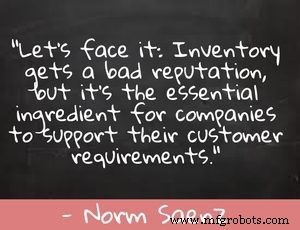
16. Inventaris mendapat reputasi buruk, tetapi ini adalah fungsi penting untuk bisnis yang mencakup hampir setiap industri. “Mari kita hadapi itu:Inventaris mendapat reputasi buruk, tetapi itu adalah unsur penting bagi perusahaan untuk mendukung kebutuhan pelanggan mereka. Mereka harus memiliki apa yang dibutuhkan pelanggan sasaran mereka untuk mempertahankan bisnis mereka dan mengalahkan persaingan. Fakta terakhir ini adalah mengapa begitu banyak perusahaan menyimpan persediaan yang bergerak sangat lambat atau "mati" di rak.
“Persyaratan persediaan di perusahaan tertentu bervariasi berdasarkan persyaratan dukungan pelanggan dan jenis bisnis sebagai produsen, pengecer , distributor grosir, atau perusahaan e-commerce. Bahkan dalam kategori saluran umum ini, akan ada perbedaan yang signifikan dalam pengelolaan persediaan di bidang farmasi/obat, makanan, pakaian jadi, barang umum, otomotif, elektronik, bahan bangunan, dan jenis usaha lainnya.
“Sedangkan industri dan jasa tingkat mempengaruhi praktik persediaan, ada alasan bisnis umum mengapa beberapa perusahaan memiliki persediaan berlebih, seperti rantai pasokan dan risiko dan ketidakpastian vendor; permintaan pelanggan variabel dan akurasi perkiraan; meratakan musim; masalah waktu tunggu; lindung nilai harga; risiko kehilangan pelanggan setia; dan pemasaran mendorong penjualan dengan barang dagangan baru.” – Norm Saenz, direktur pelaksana di St. Onge; Don Derewecki, konsultan senior di St. Onge, Manajemen Inventaris 101:Saatnya meninjau kembali prinsip-prinsipnya , Manajemen Logistik; Twitter:@LogisticsMgmt
17. Kontrol inventaris yang buruk sebenarnya merupakan gejala dari masalah yang jauh lebih dalam, seperti pemeliharaan yang buruk atau rencana pengelolaan fasilitas. “Waktu Henti:Ini adalah kata yang ditakuti oleh setiap manajer di industri pemeliharaan dan keandalan. Dalam situasi terbaik, itu berarti kehilangan keuntungan. Paling buruk, itu berarti kehilangan pekerjaan Anda. Meskipun tidak semua masalah yang menyebabkan downtime benar-benar dapat dihindari, ada baiknya untuk mengetahui masalah-masalah yang ada. Dalam posting blog ini, kita akan memeriksa beberapa cara jitu untuk menghilangkan downtime dengan beberapa tips pengendalian inventaris.
“Anda mungkin bertanya pada diri sendiri apa hubungannya pengendalian inventaris dengan apakah toko mengalami downtime atau tidak. , yang akan saya jawab, 'banyak'. Kontrol inventaris yang buruk adalah gejala dari masalah yang jauh lebih dalam, yaitu rencana manajemen pemeliharaan dan/atau fasilitas yang buruk.
“Salah satu langkah kunci untuk sistem manajemen pemeliharaan apa pun mengetahui setiap peralatan di bawah tanggung jawab Anda. Ini termasuk informasi tentang mesin juga, termasuk berapa umur setiap unit, siapa vendornya, informasi kontak vendor, harapan hidup produk, prosedur perawatan yang disarankan… daftarnya terus bertambah.
“Dengan mengetahui informasi penting ini, Anda dapat mengembangkan rencana pemeliharaan yang baik untuk memastikan peralatan Anda terus berfungsi dengan baik, sehingga membantu menghindari kemungkinan skenario waktu henti di masa mendatang.” – Lisa Richards, Hapus Waktu Henti dengan Tips Kontrol Inventaris Ini , MapCon; Twitter:@MAPCONtech
18. Kontrol inventaris, meskipun penting, masih merupakan fungsi yang masih ketinggalan zaman di beberapa tempat, seperti kantor penyedia layanan kesehatan. “Banyak kantor tidak memiliki sistem kontrol inventaris dan, oleh karena itu, mengalami kekurangan pasokan yang mengharuskan pemesanan di menit-menit terakhir dengan harga premium. Sebagian besar praktik tidak mampu, atau tidak memiliki volume untuk mendukung, sistem kontrol pemindai digital. Biaya ketidakefisienan dokter karena item yang hilang seringkali lebih tinggi daripada biaya persediaan.
“Sistem manual berikut ini sederhana, mudah digunakan, yang menempatkan kontrol inventaris di tangan satu orang sementara masih mengizinkan siapa pun di kantor untuk menggunakan persediaan saat dibutuhkan tanpa harus memeriksanya terlebih dahulu dengan orang lain. Sub-sistem untuk menyimpan setiap ruang pemeriksaan atau stasiun kerja juga dapat dibuat jika diinginkan.
“Sistem:
- Tentukan siklus pembelian untuk setiap item (seberapa sering Anda akan berbelanja:mingguan, bulanan, triwulanan, dll.) bergantung pada pemanfaatan dan ruang penyimpanan. Sebagian besar kantor harus memesan persediaan mingguan atau bulanan. Jika Anda memiliki sub-sistem untuk ruang ujian atau stasiun kerja, maka siklus Anda akan berlaku untuk mengisi kembali area tersebut dari ruang persediaan.
- Tentukan jumlah setiap item yang biasanya digunakan selama setiap siklus pembelian.
- Awalnya, beli cukup setiap item untuk bertahan selama dua siklus pembelian, dan buat dua bundel untuk setiap item. Setiap bundel harus berisi cukup setiap item untuk bertahan satu siklus pembelian (kecuali untuk item dengan tanggal kedaluwarsa atau item musiman seperti vaksin flu). Bungkus setiap bundel dengan seutas tali atau karet gelang, atau masukkan setiap bundel ke dalam kotak, tas, atau wadah lain yang terpisah. Untuk setiap bundel, lampirkan tag yang dapat digunakan kembali berlabel nama item, pemasok, harga terakhir yang dibayarkan per unit, siklus pembelian, jumlah pesanan, dan jumlah item bundel.
- Pasang dengan jelas gantung amplop bertanda “Pesan ulang amplop. Letakkan tag di sini” di ruang persediaan.
- Saat persediaan dibutuhkan, staf mana pun dapat mengakses bundel, melepas tag, dan memasukkan tag ke dalam amplop pemesanan ulang. Satu bundel penuh dan satu bundel sebagian harus tetap ada untuk item yang diakses.
- Tugaskan petugas kontrol inventaris untuk memproses tag dan label kontrol inventaris dan memesan persediaan baru sesuai dengan siklus pembelian. Jika petugas Anda memesan persediaan secara online, mintalah dia untuk memeriksa apakah pemasok online memiliki fungsi di mana pemesanan ulang yang sama dengan salah satu paket Anda dapat dilakukan dengan cepat dan mudah.
- Saat persediaan tiba, petugas kontrol inventaris harus menjadi satu-satunya yang membuka pengiriman, membandingkan faktur pengiriman dengan pesanan asli untuk mengonfirmasi keakuratan, dan menyimpan barang.
- Paketkan ulang item, dan pasang kembali tag bekas ke bundel baru untuk menyelesaikan siklus pemesanan.
- Tempatkan bundel item baru di belakang bundel yang tersisa, yang mungkin sudah dibuka jika permintaan item melonjak secara tidak terduga (misalnya, untuk merotasi inventaris).
“Anda dapat mengubah pemasok, siklus pembelian, jumlah pesanan, dan ukuran bundel kapan saja sesuai kebutuhan. Cukup ubah tag untuk mencerminkan perubahan.” – Keith Borglum, T&J:Kiat menghemat uang untuk persediaan dan mengontrol inventaris , Jaringan Kedokteran Modern; Twitter:@MedEconomics
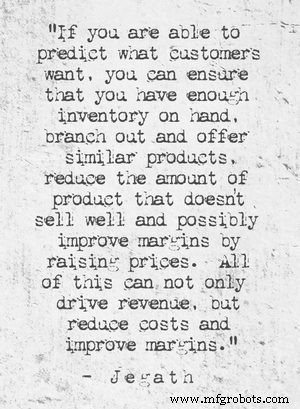
19. Usaha kecil tidak boleh mengabaikan kebutuhan akan sistem pengendalian persediaan yang solid. Saat mempertimbangkan metode dan aplikasi perangkat lunak, daripada memilih aplikasi yang paling murah atau gratis, pilihlah sistem yang dapat berkembang bersama bisnis Anda. “Anda mungkin berpikir bahwa karena bisnis Anda kecil, Anda tidak perlu menghabiskan banyak waktu dan uang untuk melacak inventaris saya. Dengan ukuran bisnis Anda, Anda bisa mengawasinya sendiri tanpa perlu menyiapkan sistem khusus.
“Alur pemikiran ini bisa membuat Anda bermasalah. Manajemen inventaris melibatkan lebih dari sekadar menghitung inventaris Anda. Sistem manajemen inventaris yang baik juga mencakup pelacakan inventaris saat dikirim ke pelanggan. Dari manajemen inventaris yang tepat, Anda dapat mempelajari produk apa yang terjual dengan baik dan mana yang tidak sehingga Anda tahu apa yang harus disimpan lebih banyak dan item mana yang perlu dipertimbangkan untuk dijual untuk memindahkannya. Jika Anda dapat memprediksi apa yang diinginkan pelanggan, Anda dapat memastikan bahwa Anda memiliki persediaan yang cukup, membuka cabang dan menawarkan produk serupa, mengurangi jumlah produk yang tidak laku, dan mungkin meningkatkan margin dengan menaikkan harga. Semua ini tidak hanya dapat mendorong pendapatan, tetapi juga mengurangi biaya dan meningkatkan margin.
“Perangkat lunak manajemen inventaris bisnis kecil juga dapat membantu manajemen kas. Dengan memahami produk mana yang dijual dan menggunakannya untuk mengontrol perilaku pembelian Anda menjadi tepat waktu, Anda dapat mengurangi siklus konversi tunai untuk bisnis Anda. Sama halnya, dengan menghilangkan produk dan skus yang tidak laku, Anda dapat mengurangi jumlah uang tunai yang terikat dalam produk konversi uang tunai panjang. Semua ini sangat penting untuk usaha kecil. Pertanyaannya bukan 'apakah saya memerlukan sistem manajemen inventaris' tetapi 'berapa banyak uang dan waktu yang harus saya investasikan'. Kemudian Anda juga perlu mempertimbangkan pertumbuhan. Beralih sistem nanti bisa sangat mengganggu dan menyakitkan. Meskipun perangkat lunak manajemen inventaris gratis tersedia untuk bisnis kecil Anda, itu mungkin bukan strategi jangka panjang terbaik. Lebih baik membeli layanan atau produk yang dapat tumbuh bersama Anda.” – Jegath, Kiat untuk Pemilik Usaha Kecil:Mendorong Pendapatan melalui Perangkat Lunak Pengelolaan Inventaris Usaha Kecil , Blog Ordoro; Twitter:@ordoro
20. Untuk organisasi pemeliharaan, mudah jatuh ke dalam perangkap pemikiran bahwa CMMS yang tepat juga akan memecahkan tantangan pengendalian inventaris perusahaan. Namun, perangkat lunak pemeliharaan hanya mengotomatiskan dan menyederhanakan proses yang sudah efektif. “Manajemen inventaris yang efektif adalah salah satu cara terbaik untuk mempercepat ROI implementasi CMMS Anda. Melacak inventaris, bagaimanapun, bisa menjadi tugas yang kompleks dan menakutkan. Organisasi harus melacak berbagai peralatan, serta suku cadang dan peralatan yang digunakan untuk memelihara peralatan tersebut dengan benar.
“Untuk waktu yang lama, organisasi harus melakukan manajemen inventaris secara manual. Kesulitan melacak inventaris dalam jumlah yang berbeda dan dengan karakteristik yang berbeda-beda semakin diperbesar ketika prosedur manual digunakan. Modul kontrol inventaris dapat menyederhanakan manajemen inventaris melalui pencatatan yang lebih baik dan pelaporan otomatis. Sayangnya, modul manajemen inventaris sering kurang digunakan.
“Banyak manajer pemeliharaan secara keliru berasumsi bahwa manajemen inventaris datang sebagai fungsi otomatis dari sistem manajemen pemeliharaan, tetapi perangkat lunak pemeliharaan hanya dapat menyederhanakan dan mengotomatiskan proses yang sudah efektif.” – Carol Owens, Kiat untuk Menyederhanakan Manajemen Inventaris dengan Software Kontrol Pemeliharaan , Bisnis-Software.com; Twitter:@BiznessSoftware
21. Apa pun sistem, metode, dan kebijakan inventaris yang Anda terapkan, selalu siapkan rencana cadangan untuk melindungi data berharga perusahaan Anda. “Lindungi semua kerja kerasmu. Bahkan sistem inventaris yang paling berteknologi tinggi dan terorganisir dapat menjadi bencana besar jika Anda tidak memiliki rencana cadangan. Bagaimana jika, misalnya, komputer canggih Anda dicuri atau kebakaran merusak fasilitas Anda, membuat catatan tertulis Anda menjadi tumpukan abu? Hindari skenario bencana ini dengan juga mencadangkan sistem Anda di tempat lain, bahkan mungkin ke thumb drive yang dapat dilepas.” – Stephanie Howard, Kiat Untuk Mengontrol Manajer, Pemasok, dan Inventaris Anda , Groovv; Twitter:@GroovvSolutions
Data Collection and Analysis Tips for Effective Inventory Control
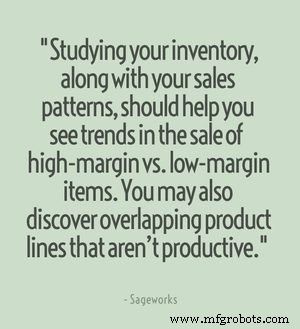
22. Find a way to evaluate what products are moving and what products are not. “One of the first ways to use your inventory information is to examine by product what is moving and what isn’t. Doing this on an ongoing basis will help identify products that may need to be discounted in order to replace them with faster selling items or in order to generate some cash. Studying your inventory, along with your sales patterns, should help you see trends in the sale of high-margin vs. low-margin items. You may also discover overlapping product lines that aren’t productive.” – Sageworks, 6 Tips to Improve Inventory Management , Funding Gates; Twitter:@FundingGates
23. Measurement is essential. You cannot control what you don’t measure. “Metrics are essential to a well-run supply chain. Metrics for their own sake, however, are worthless. The purpose of a metric is to drive change when the variable you are measuring trends in the wrong direction.
“A number of different metrics are useful for inventory management. Days supply by product and location based upon forecast is an excellent metric at the SKU level.
“When analyzing roll-up numbers for a product line, warehouse, or any other higher level, however, days supply is misleading because the lows cancel the highs and hide imbalances. At the higher level, inventory velocity is a much better measure of inventory health.
“No metric is useful, however, unless it is acted upon. Constant vigilance and early response to imbalances are the keys to ensuring best-practice inventory management.” – Jane B. Lee, 8 Common-Sense Rules for Inventory Management , Inbound Logistics; Twitter:@ILMagazine
24. Calculate your total costs. “It goes without saying that getting your inventory levels right is imperative, but what about the right quantities of your highest-performing brands and products? Maximizing sales of the goods with the most attractive margins can sometimes be tricky because of quantity discounts, special orders, and changes in wholesale prices (that you might not be aware of).
“It’s why looking carefully at total costs lets you know which products have the best margin, rather than just sell the fastest.
“Why calculate total costs?
- Focus on brands and vendors that yield the highest profits
- Find out which products perform the best by quantity margin
- Better manage discounts with a precise account of item cost” – Stephanie Braun, Fun Tips! 5 Ways To Improve Inventory Control Today , Lightspeed POS; Twitter:@LightspeedHQ
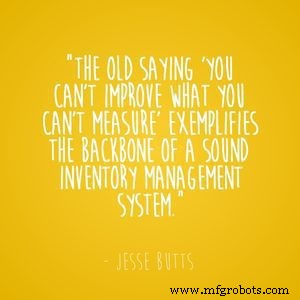
25. Track both inventory and sales data. “The old saying ‘you can’t improve what you can’t measure’ exemplifies the backbone of a sound inventory management system. If you haven’t yet started keeping thorough records, there’s no time like the present. As you create this records system, consider how it will accommodate the most vital inventory components:
- sales orders — documents comprising your customers’ purchase orders (requests for your product or service) in a format tailored for your business
- bills of materials — documents stating the inventory components (and hopefully labor) required to complete products or services
- work orders — if you’re involved in manufacturing, you’re probably familiar with these documents that include products’ details and their respective bills of materials
“You likely already have a system for recording transactions that includes sales orders (we hope). But most entrepreneurs haven’t taken the time to complete bills of materials, and for good reason:They are time-consuming. But, in the end, the benefits far outweigh the costs.
“Bills of materials are considerably easier to create for a retail storefront than for, say, a restaurant. In the food service industry, one sales order can relate to multiple bills of materials which, in turn, can require a few primary components and many others in small amounts. If you fall into the latter camp, determine the quantities of various invoice items needed for the appropriate bills of materials.” – Jesse Butts, How to Establish a Practical Inventory Management System , BizFilings; Twitter: @Toolkit
26. Check all stock inwards to account for errors in packing and other issues that may be missed if you simply assume the numbers match up. “The first focus should always be to check what actually gets delivered against what you have ordered from your supplier. It is so easy to assume that the numbers match up, but from talking to our customers we note that a good 1% to 2% of stock orders are incorrectly packed. If you just assume that you have the correct numbers of products when you add the inventory to your shelves you are liable to be short stocked when you receive a customer order. Another issue is that you might actually have more stock than you need and you won’t know when to reduce prices to move it or order more when you don’t need to.” – Stock Control and Inventory Management Tips , Cloud Fulfillment; Twitter:@CloudFulfillment
27. Centralize your data. “Regardless of how your inventory is set up physically, from a tracking perspective it should all be consolidated. This is especially the case if you have a web store and a physical one. Otherwise, you’ll appear disorganized and the process of buying could be confusing. As a bonus, being able to order online and either pick up or return in-store can seriously boost sales.” – 5 Tips for Streamlining Your Inventory Control Process , Blue Chip Inventory Service Int’l.; Twitter:@rodwalsh98
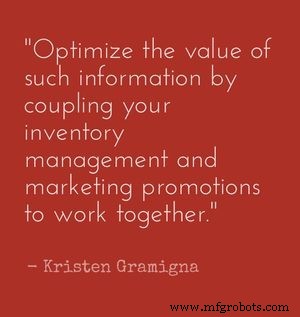
28. Inventory trends inform marketing plans. “Accurate inventory management incorporates what you know about customer and product demand from the past and present to (ideally) predict your best course of action in the future. A point of sale system can help quantify product level demand in tandem with recurring sales patterns, including those that fluctuate with some predictability (like seasonality, lifestyle occasions that impact your target audience and perhaps, local events).
“Optimize the value of such information by coupling your inventory management and marketing promotions to work together. For example, such insights can reveal potential opportunities to leverage quantity-based pricing vendors may offer, while at the same time empowering you to offset times of lower demand with promotions or ‘packaged’ deals that strategically drive sales, while moving the inventory that you acquired at a low cost.” – Kristen Gramigna, Keep Track of Your Precious Cargo:Tips for Inventory Management , Business.com; Twitter:@businessdotcom
29. Automate tracking with barcode labels and/or inventory management applications. “Another possible inventory management error is failure to track what you receive and what you sell. This can lead to losses, especially if you’re paying for products that are never showing up at your business, so some sort of tracking system is imperative. Automating the process with a barcode system and/or inventory management application is the smoothest way to handle this; note that the BizXpert app offers some useful inventory management features.
“Cycle counts are also recommended. Every day, pick a handful of items and count how many you have, comparing the number against what you have in your records. Pay special attention to big-selling and hot ticket items.” – Three Inventory Management Errors (And How to Avoid Them) , BizXpert; Twitter:@BizxpertApp
30. For many industries, including healthcare, inventory tends to follow the 80/20 rule. “Hospital inventory, like many things in life, often follows an 80/20 rule. 80% of the value of your inventory will be composed of just 20% of your actual product and most of those valuable items – whether they be assets, med-surg supplies, consignments or medication – fall into the departments of OR or Pharmacy. Plan your inventory efforts accordingly. Spend 80% of your time and energy optimizing the ordering and organization of the equipment, supplies and pharmaceutical products in these categories.” – Top 10 Tips for Hospital Inventory Management , Reliant Inventory Services
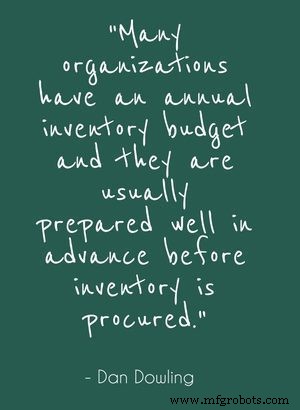
31. Inventory budgeting is a critical component of effective inventory control. “Many organizations have an annual inventory budget and they are usually prepared well in advance before inventory is procured. Budgets should include the total cost of ownership to keep inventory on hand during that year’s account period. This includes materials cost, fixed operational costs, carrying costs, logistics costs, redistribution costs and additional miscellaneous costs that contribute to the total costs of ownership.” – Dan Dowling, 6 Inventory Control Techniques for Stock Optimization , EazyStock Blog; Twitter:@EazyStock
32. When considering new inventory control software applications, be sure the cost is commensurate with functionality. “As you might expect, there are a lot of different types of inventory planning and control software out there. One of the biggest differences between many new solutions is whether they take advantage of cloud computing, or if they remain as locally installed software packages. For example, according to Inc.com , many providers of inventory control systems offer exclusively online, and full-service hybrid, versions of their software. The exclusively online versions are typically more limited in their functionality, while the full-service versions come with a higher price tag, but offer a greater number of services.” – Pat VanPutte, Inventory Control Systems Protect Your Bottom Line , NSA Computer Exchange Corp.; Twitter:@NSAComputerExch
Knowing Your Inventory and Your Company’s Needs
33. Don’t get caught with too much inventory. “Afraid of being caught short, it’s easy to spend too much on inventory, which can eat up working capital and erode profits. Warehousing isn’t free, of course, and inventory that sits on a shelf is subject to damage, depreciation, and even obsolescence. Old inventory can be very hard to move. Your options aren’t great,’ says Paul Huppertz, a logistics expert with The Progress Group, a supply chain consulting company based in Atlanta. ‘You may end up marking it down, selling to discounters, or shipping it to overseas liquidators.’
“To fix it: Start with some decent projections of how much supply you’ll need and when you’ll need it. The best gauge is what you’ve sold in the past. If you’ve sold 100 items per month for the past 12 months, chances are that you’ll need 100 this month. Then there’s seasonality:Do you usually see a fourth quarter spike with holiday sales? Or, if you’re in the home and garden business, do you see more activity in the spring selling season? ‘You can also identify and quantify less obvious patterns such as month-end spikes,’ says Huppertz.” – Lisa Girard, Five Steps to Painless Inventory Management , Entrepreneur; Twitter:@lisagjournalist
34. You should be able to break down your inventory into three basic categories:safety, replenishment, and excess or obsolete stock. “This breakdown makes it easier to make sound decisions about appropriate levels for each of these three areas. It helps determine the minimum safety stock needed to provide an insurance policy against supply chain problems either from manufacturing glitches or distribution uncertainties so that customers get what they ordered. It’s useful for pinpointing the amount of inventory required to replenish deliveries every two weeks. And it helps companies find ways to avoid a backlog of excess or obsolete inventory.” – Pratap Mukharji, Sam Israelit, Francois Faelli, Thierry Catfolis and Raymond Tsang, Ten ways to improve inventory management , Bain &Company; Twitter:@BainAlerts

35. Even with the most sophisticated automated data collection systems, a regular inventory audit is still valuable for keeping precise tabs on your inventory. “Make sure to regularly, on a monthly basis if possible, audit your inventory to sufficiently keep track of all of your stock. Even with all of the great technology available to us, we need to keep track of items and orders. This will help you to understand what is really selling and what is dead stock. Getting rid of dead stock is key to running an efficient warehouse operation. All you have to do is create a list of every product you have on your shelves – simple really.” – 5 Helpful Tips for Easy Inventory Control , Personal Finance and Business Advisor
36. Don’t be afraid to re-evaluate your company’s inventory control needs. “At what point do you realize that your approach to inventory management needs to change?
“Is it when you’re re-ordering an item you know you just ordered last week?
“Is it when you’re sending someone out for a 4-1/2-inch grinder and they’re gone over an hour?
“Or maybe it’s when you realize that you have hundreds of thousands of dollars—maybe millions—tied up in inventory, but you still don’t have exactly what you need the moment you need it.“If this sounds familiar, you’re not alone.“These are common practices in manufacturing environments where meeting production standards and schedules is the number-one priority, no matter what the cost. At some point, however, your finance department may recognize just how much time, money, resources and valuable shelf space is wasted on less–than–perfect inventory management practices. These days every company wants to streamline operations, improve productivity and gain that competitive edge. If you haven’t done it yet, re-evaluating your own inventory management system can help you accomplish some of these goals and significantly boost your bottom line.”
– 5 Tips for Getting Started With Vendor-Managed Inventory , Grainger; Twitter:@grainger
37. A CMMS is the backbone of effective inventory management and control for facilities. “The CMMS is the backbone of inventory management and control. Besides the typical modules —work orders, equipment records, material stores inventory, project management, standard reports, work-scheduling databases — the CMMS query system can yield summary inventory reports that supervisors and managers need.
“When each work-order status indicates the material is available, the work order is ready to go, and the maintenance planner can schedule it with the confidence that a lack of materials will not delay the job. Managers also can monitor the trend of work orders awaiting material.
“With real-time inventory control, the need for physical inventory decreases, especially if entries are accurate and complete. Out-of-stock trends can alert the stores supervisor to specific items that need expediting before they lead to equipment downtime. Managers also can monitor inventory-valuation trends efficiently.” – Thomas A. Westerkamp, CMMS:Backbone of Inventory Management and Control , FacilitiesNet; Twitter:@Maintenance_Mag
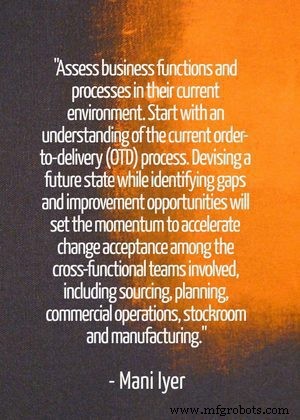
38. Conduct a business assessment. “Assess business functions and processes in their current environment. Start with an understanding of the current order-to-delivery (OTD) process. Devising a future state while identifying gaps and improvement opportunities will set the momentum to accelerate change acceptance among the cross-functional teams involved, including sourcing, planning, commercial operations, stockroom and manufacturing. Key activities in this stage should include:
- Study “As-Is” planning and execution process within the OTD process . Aim to have an unbiased assessment of current processes and practices. Start by interviewing a representative set of stakeholders who perform the same job within each function of the OTD process. Follow up with brainstorming sessions that involve key stakeholders from each function, which will help them understand their upstream and downstream process and address any issues arising out of lack of clarity of roles and responsibilities. These stakeholders should also voice their opinion on the desired “As-Is” state to establish a baseline against which improvements can be measured, and to effectively manage change through shared responsibility among their teams. Organizations should also consider conducting lean workouts among a cross-functional team of subject matter and Six Sigma process experts to understand redundant and non-value-added steps in the process due to multiple hand-offs between various functions within the OTD process.
- Summarize findings and gaps in data, process and practices. One of the ways to effectively capture the gaps in material planning and execution practices is through self-evaluation score sheets. A score sheet typically enlists the various planning and execution categories, and asks the functional owners to score according to the importance and effectiveness of each practice. Typical scoring criteria used is 1 (low), 5 (medium) and 9 (high) to clearly differentiate high impact gaps from lesser ones. For a more robust and objective view, third party service provider can also assist with benchmarking current processes against some of the best run companies in the industry.
- Devise “To-Be” planning and execution OTD process. Resource and system limitations may warrant a “To-Be Intermediate” state before moving to the ideal state. The objective is to outline a streamlined, robust and sustainable process that is aligned to the overall objective of optimizing inventory, customer service levels and variable costs. Organizations then begin to migrate to ideal state once resource and system limitations are addressed.
- Communicate to the whole group the identified improvement opportunities and goals . One of the biggest challenges faced during assessment is change resistance. Data-based inferences and identification of change catalysts is the key to driving fast adoption of more easily implemented improvements. By seeing immediate results, stakeholders will be better engaged to support additional and more sweeping process changes.” – Mani Iyer, Senior Business Manager, Genpact, Inventory Optimization:Five Steps to Improve Process Effectiveness , IndustryWeek; Twitter:@IndustryWeek
39. Understand your sales cycle and customer buying patterns to gain a better understanding of your customers. Effective inventory control is essential for customer service. “Inventory control is a customer service issue. Successful inventory management involves striking that balance between not having enough inventories on hand and having too much. Either you have the cost of excess inventory or the cost of a lost sale. It is painfully obvious which is lesser evil of the two.
“In order to conduct proper inventory control, you must have the ability to look at past sales and predict future demand. When forecasting your demand, you must learn from your past mistakes. Previous marketing promotions must be tracked closely to measure the impact of sales increases. Understanding your sales cycle and customer buying patterns will help you gain a greater understanding of your customers.” – James Ellis of Central Oregon Community College, Inventory Control:An Essential Element of Good Customer Service , Cascade Business News; Twitter:@cascadebusnews
40. Effective inventory control can reduce harmful consequences from mishaps such as the use of outdated or expired materials, such as those used in pharmacy preparations. “Large pharmacies, especially compounding pharmacies, often produce “stores of unwanted chemicals” used in the preparation of prescriptions. These chemicals are known as “bulk compounding chemicals,” and include substances such as tar, phenol and sulfur. Between the chemicals used to prepare prescriptions, pharmacies must also keep track of the compounds and drug products that are ingredients of the final medications. Given the many materials and types of chemicals used and produced, it is especially important for managers to use chemical inventory management systems to organize and keep track of the chemicals that enter and leave a facility.
“As mentioned above, the NECC used expired ingredients in their medications, which likely exposed a number of patients to adverse effects. Additionally, chemicals were not properly labeled. Using a chemical inventory management system prevents such oversight and in all likelihood, NECC lacked such a system. For compounding pharmacies and other such companies which would greatly benefit from tracking chemical supplies, let’s examine three ways a chemical inventory management system can help improve life for both employees and customers:
- Accurate data: The FDA has promised to clamp down on compounding pharmacies as a result of 2012’s incident; however, a random inspection should not be a reason to stress when facilities have a best practices chemical inventory management system in place. Many systems have gone completely digital by using barcode labeling and even providing remote inventory control. In this way, researchers and pharmacists can easily update inventory records, thus providing accurate and real-time data on the chemicals in stock.
- Expiration no more: Expired medications can be dangerous for patients; however, monitoring the expiration dates for both the chemicals used to produce prescription drugs as well as the chemical components of these drugs can be overwhelming. With a chemical inventory management system, managers can easily monitor expiration dates remotely, thus uncovering new opportunities for saving money by ordering less of a minimally used chemical, for example.
- Promote a safety culture: The most damning evidence against the NECC was its inability to create a culture of safety, one in which clear standards and practices are present and individuals are aware of the locations and proper disposal of items. The absence of such a culture perhaps helped contribute to the contamination of medications and it is no wonder that 14 former NECC executives and technicians were indicted on federal charges related to the outbreak. By implementing a chemical management system, leaders help ensure that employees understand the importance of safety and may act accordingly to protect the interests of all.
“What occurred at the NECC proved to be a fatal flaw for the company. Though the presence of a chemical management system may not have prevented the outbreak, if such a system were in place and used in conjunction with a digital notebook capable of recording the results of sterility tests, for example, the likelihood that such a mistake could occur would have been much less.” – Lilian N., Eliminating Harmful Substances Before They Reach Patients with Chemical Inventory Management , Biovia; Twitter:@3dsBIOVIA

41. If your company must maintain inventory for equipment repairs, consider parts that can be used in a number of applications. “If you store clamps and couplings that can be used in a number of applications, you won’t need to keep as many in stock and space is reduced. Full transition couplings that fit pipes of varying types and sizes within your water or wastewater infrastructure save space and help you stay prepared for multiple scenarios. There are also products that have the versatility to either join or repair pipes.” – David Wheat, Simple Steps For Inventory Control , Municipal Sewer &Water; Twitter:@MSWmagazine
Creating Effective Inventory Control Policies
42. Creating clear policies and processes allows your company’s inventory control function to run like a well-oiled machine. “It can be an uphill battle keeping your company’s inventory effectively organized and managed. There are some subtle nuances that are easy to overlook but should ultimately not be ignored. Compass Technologies, which provides retail point-of-sale, wholesale and distribution services to its customers, offers some helpful advice for inventory and organization management.
- Limit access to inventory. Only those who need to have their hands on inventory and inventory data should be allowed access.
- Establish well defined, user-friendly storage and receipt management policies. Check lists and data tables.
- Create an inventory system that utilizes multiple locations to replenish inventory from multiple sites – minimize distribution costs.
- Clearly map and label inventory areas, easy to read and understand with item descriptions.
- Track annual and seasonal regular inventory demand analysis. Use competitive data for start-up companies.
- Track and document inventory processes, including reviews.
- Inventory data base- GP and Add-On solutions.
- Use inventory alerts to make management aware of stock limits.
- Manage paperwork, purchase orders, receipts and inventory counts with GP for reporting.
- Utilize software add-on solutions to further manage the inventory process.” – Hillary Horning, Compass Technologies, 10 Tips for Smooth and Accurate Inventory Organization and Management , ERPSoftware Blog; Twitter:@erpsoftwareblog
43. All items should have an SKU, barcode, and product specifications. “Similar to a driver’s license, every product needs to have a unique ID number known as a SKU (Stock Keeping Unit). A SKU is vital for internal use as there will be instances where a particular product needs to be found quickly and having an SKU will make it easy to find. Additionally, having a SKU is imperative because another company could have a product named “Black Pants” exactly like and resellers are dealing with multiple vendors, thus creating a need to differentiate between similar products.
“Second, when working with other companies such as resellers whether it be an independent e-commerce store, a brick and mortar store or a big-box chain, a universal barcode/UPC number will be expected. A UPC number is another form of a SKU, but instead it comes in the form of a barcode which can be scanned and identified through a live database powered by GS1. Be cautious not to purchase UPC numbers from anywhere but GS1 or a valid reseller. The whole point of a barcode is to be scanned and looked up via a database, so having a barcode that brings up a different product from another company causes a lot of confusion and could potentially lose customers.
“Finally, it is always good to have a system for listing all your products specifications. Those specifications should have at least the following:
- Product Name
- SKU Number
- UPC Number
- Description
- Color
- Size
- Price
- Weight
- Dimensions (depending on product)” – Raad Mobrem, 6 Tips for Inventory Management , Small Biz Resources; Twitter:@SmallBiz_Help
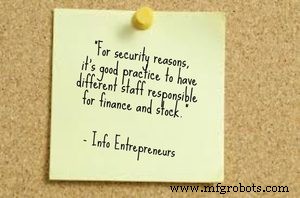
44. Dedicated inventory control managers or other administrators should be tasked with handling the administrative tasks associated with inventory control, and these roles should be separate from accounting or finance departments. “There are many administrative tasks associated with stock control. Depending on the size and complexity of your business, they may be done as part of an administrator’s duties, or by a dedicated stock controller.
“For security reasons, it’s good practice to have different staff responsible for finance and stock.
“Typical paperwork to be processed includes:
- delivery and supplier notes for incoming goods
- purchase orders, receipts and credit notes
- returns notes
- requisitions and issue notes for outgoing goods
“Stock can tie up a large slice of your business capital, so accurate information about stock levels and values is essential for your company’s accounting.
“Figures should be checked systematically, either through a regular audit of stock – stocktaking – or an ongoing program of checking stock – rolling inventory.
“If the figures don’t add up, you need to investigate as there could be stock security problems or a failure in the system.
“Health and safety aspects of stock control are related to the nature of the stock itself. Issues such as where and how items are stored, how they are moved and who moves them might be significant – depending on what they are.
“You might have hazardous materials on your premises, goods that deteriorate with time or items that are very heavy or awkward to move.” – Stock Control and Inventory , Info Entrepreneurs; Twitter:@chambremontreal
45. Make inventory accuracy a higher priority than order fulfillment. “Raising the priority of accurate inventory is perhaps the most important, yet most difficult, step in inventory accuracy. Many inventory problems arise from pushing a transaction through the system with the intent of going back and fixing the numbers later. In the rush of other emergencies, however, we often forget to go back and correct the numbers in the system. This leads to missed production entries, negative lines of inventory, and a whole mess of other problems. Only by putting systems in place that will prevent an employee from moving forward without the necessary system transaction can you effectively keep accurate records of inventory.
“One example of success that my team recently implemented was changing our accounting system so that it will not process any shipment that contains more inventory than we have on hand. For example, if we’re trying to ship 15 of an item, but our system says we only have 5 in stock, then an alert will pop up and force us to fix the problem before moving forward. This helps us address problems before the product goes out the door. By forcing us to address missed production entries before the product leaves, our modified system helped us eliminate most of our major inventory issues.” – Alex Fuller, 10 Tips to Make Physical Inventory Counts Less Painful and More Accurate , Supply Chain Cowboy
46. Inventory management software is a valuable tool and superior to outdated spreadsheet methods. “Using the right tools for the job is a must. Many companies choose spreadsheets for inventory management software because it seems like the familiar and easy thing to do. Unfortunately, spreadsheets come with built-in risks:it’s far too easy to lose changes or accidentally delete a spreadsheet file. It’s also difficult for multiple people to synchronize their spreadsheets, which further increases the risk for error. Find a low-cost but effective software for managing your inventory, such as Peachtree or QuickBooks. Most organizations overlook these options for inventory management because they’re best known for their accounting features. However, they offer invaluable inventory management software features and a central database to streamline inventory operations, increase accuracy, and minimize the possibility of error.” – 5 Supply Chain Management Inventory Tips , Women’s Distributor Services (WDS); Twitter:@WDSJennifer
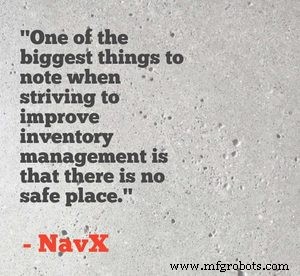
47. Optimizing inventory control requires continuous improvement. “One of the biggest things to note when striving to improve inventory management is that there is no safe place. Maintaining the right balance of inventory levels, properly organizing your warehouse for maximal efficiency, and ensuring that you have complete insight into your processes will go a long way in helping you improve effective inventory management however when you think you’ve succeeded, the worst thing you can do it sit back and relax. Taking a critical approach to operations, including inventory management, is fundamental to maintaining your competitive edge. Be sure to monitor costs as well as performance; if you see that inventory carrying costs are rising, maybe your forecasting isn’t as accurate as it could bet. If customer satisfaction falls, take a look at your order history. If you’re sending out incomplete orders, or items aren’t being sent to customers in a timely manner, dig a little bit deeper. By building the philosophy of continuous improvement into your organization and your inventory management strategy, you will be able to achieve greater efficiency and profitability.” – 3 Tips for Improved Inventory Management , NavX; Twitter:@NAVX_software
48. Cycle counts can be a useful alternative to stock-wide physical inventory counts. “Cycle-counts have become SOP with a growing number of mid-sized firms since more business software packages now provide this functionality. The benefits of employing a cycle-count regimen over periodic stock-wide physical counts are great. Cycle-counts are less disruptive to operations, offer greater specificity in determining what items should be counted and generally force greater discipline into the organization’s inventory management.” – Tips for Improved Inventory Control:Part 5/8 , TBS Automation Systems
49. Take steps to maximize both your profit and resources by involving team members and distributors in key processes. “There are many best practices that any Supply Chain Manager should follow, but a few of the strategies that tend to ensure maximizing not only profits but resources needed include:
- Working with your team and distributor to maximize service and savings; everyone should be clear on the expectations of the strategy you have defined.
- Once strategy is implemented continue consistent monitoring of purchasing behaviors. Many times a focus on efficiencies over time begins to become complacent resulting in overpayment for suppliers and an increase in overall supply chain costs.
- Understand the difference between “cost” and “price.” Many times, the manufacturer costs revealed for the savings analysis do not include the distributor mark-up, holding costs, or the freight costs. Also remember to keep in mind that being able to secure products through a manufacturer directly needs to apply to all of their products in that category, not just one of the more highly utilized items.
- Establish your ability to purchase in the lowest unit of measure. This will ensure that you are not over-ordering on products you may not use frequently or on any consistent basis.
- Be sure of what your GPO compliance requirements are. [This] includes not only volume in units, but may also include dollar-volume commitments. It is important to remember that reducing your pricing on actual supplies may interfere or require an amendment to your GPO agreement in order to maintain compliance. Many times hospitals secure agreements that include commitment to process a set dollar volume through the GPO base agreements that must be fulfilled to maximize the benefits of the entire portfolio.” – Lori Pilla, Vice President, Amerinet Clinical Advantage and Supply Chain Optimization, Amerinet Inc., St. Louis, as quoted in More inventory management best practice tips , HPN Online; Twitter:@HPN_Online, @AmerinetInc
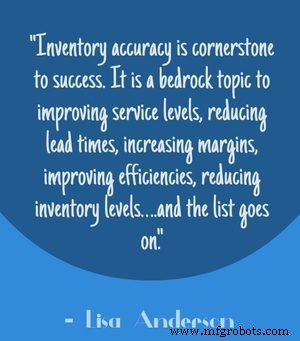
50. Follow best practices for conducting physical inventory counts. “Inventory accuracy is cornerstone to success. It is a bedrock topic to improving service levels, reducing lead times, increasing margins, improving efficiencies, reducing inventory levels….and the list goes on. Although I recommend implementing cycle counting programs as a way to replace physical inventories, there are times when a physical inventory is a must. Thus, it is worth thinking about a few tips to successfully complete a physical inventory.
- Prepare, prepare, and prepare: 80% of your success is in preparation. Organize the warehouse, clearly mark areas, label exceptions, complete and review system transactions, etc.
- Stop/isolate movement: When you begin your physical count, stop all physical and system movements and transactions. This is a critical foundation – similar to building a house, if you start adding windows prior to finishing the walls, the house might begin to fall apart.
- People and communication: Make sure the right people are in the right jobs for their skill sets. And, communicate, communicate, communicate. Make sure everyone has clear instructions, understands how to get questions answered, etc.
- Manage the control desk: This is the term I’ll use for the team organizing and controlling the process – the Grand Central Station hub. Typically, this person/team keeps track of count sheets, makes sure everything “adds up”, answers questions and keeps the process moving.
- Metrics/tracking progress: Putting the key metrics and vehicles in place to track progress is cornerstone to success. By reviewing these metrics, the leader can review progress, make adjustments as required and keep the process on track. Metrics also provide for a way to measure success.” – Lisa Anderson, Tips for Physical Inventory Success , LMA Consulting Group; Twitter:@LisaAndersonLMA
51. Give your employees tools that make them more efficient, which leads to more accurate inventory control. “Other than employees, inventory is a company’s largest asset. Reducing inventory levels and increasing inventory turns can lead to immediate savings on a company’s bottom line. Also, it’s important to consider the “landed cost” of your products. While your supplier may have a book price with bulk discounts, consider how much the product actually will cost you from the time you purchase it to the time it lands at your warehouse dock. Cargo fees, customs, and transportation add up quickly and can shrink profit margins. To navigate these challenges, consider these five tips:
- Reduce compounded safety stock: Most companies keep an extra cushion of inventory to account for unexpected demand. The problem is that when every vendor in a supply chain (raw material supplier, manufacturer, retailer) maintains that extra 5 percent to 10 percent of cushion, it adds up to unnecessary costs for each organization. The key is to communicate closely and often with your suppliers and trading partners to prevent overproduction and increased carrying cost for them. Find ways to collaborate and eliminate excess safety stock.
- Give employees tools to make them more efficient: In tough times, high-quality employees that you strive to retain can get burned out. They likely will absorb the duties of their more expendable colleagues. One way to keep them happier and more productive is to give them the technology tools that will make their jobs easier. Technology that automates tasks or offers predictive models about supply and demand will help reduce the manual aspects of their jobs, so they can focus on driving sales or broader strategies to help grow your business.
- Optimize your inventory: Simply said, you need to get rid of the inventory you don’t sell and get more of the inventory you do. The concept sounds straightforward but many small and midsize businesses have the wrong mix of inventory. While it may be painful to liquidate the inventory you spent precious resources to secure, having it take up warehouse space and require your team to manage it will cost you more in the long run. That space and mindshare could be spent on inventory that is hot and will turn over quicker, and that means more profit in your pocket. Take the short-term hit and implement a system that sheds products that don’t sell and invest in those that do.
- Focus on banner products: Growing up, there were just three kinds of soap at the grocery store:Dove, Dial, and Lava. Now a visit to the soap aisle could add another 15 minutes to a shopping trip because there are just too many choices. By adding variations to your product line versus introducing completely new and different products, you actually cannibalize your own sales and risk confusing customers to the point of apathy. Concentrate on your best products and create customer brand loyalty, which will create “customers for life” versus fickle ones.
- Manage to the future: Understand that in today’s economic climate, cash is king. If you are sitting in a good position, make cutbacks to your spending but invest in tools and people that will help you in the long run to grow your business and drive greater efficiency. With layoffs and companies eager to keep sales high, you can secure some top quality talent and excellent deals on the technology tools you need.
“In times like these, it is key to stay positive but manage realistically, cutting short-term costs that you can afford to cut. The important thing is to understand which assets are mission-critical and which ones need to be shed. Properly managing the No. 1 or No. 2 asset of your company will allow you to cut expenses and increase sales.” – Bill Harrison, Top Five Tips to Rescue Your Business with Inventory Management , AllBusiness; Twitter:@AllBusiness_com
Asset Tracking Solutions from Camcode:
- Kontrol Inventaris
- Inventory Management
- Custom Foil Labels
- Tanda Gudang
- Tanda Lorong
- Tag Baja Tahan Karat
- Label Lantai
- Label Keamanan
- Label Magnetik



















